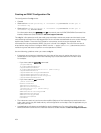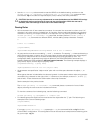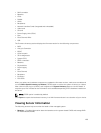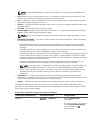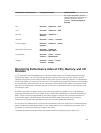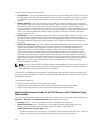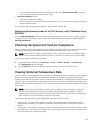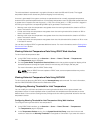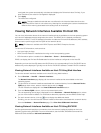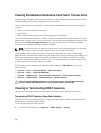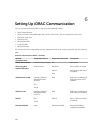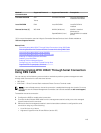
The four system utilization parameters are:
• CPU Utilization - There are individual Resource Monitoring counters (RMCs) for each CPU core which
are aggregated to provide cumulative utilization of all the cores in the system. This utilization is based
on time spent in active state and time spent in inactive state. Each sample of RMC is taken every six
seconds.
• Memory Utilization - There are individual counters (RMCs) to measure memory traffic occurring at
each memory channel or memory controller instance. These counters are aggregated to measure the
cumulative memory traffic across all the memory channels on the system. This is a measure of
memory bandwidth consumption and not amount of memory utilization. iDRAC aggregates it for one
minute of period, so it may or may not match the memory utilization shown by other OS tools such as
TOP in Linux. Memory bandwidth utilization shown by iDRAC is indication of whether workload is
memory intensive or not.
• I/O Utilization - There are individual Resource Monitoring Counters (RMCs), one per root port in the
PCI Express Root Complex to measure PCI Express traffic emanating from or directed to that root
port and the lower segment. These counters are then aggregated to measure PCI express traffic for all
PCI Express segments emanating from the package. This is measure of IO bandwidth utilization for
the system.
• System Level CUPS Index - The CUPS index is calculated by aggregating CPU, Memory, and I/O index
considering a pre-defined load factor of each system resource. The load factor depends on the
nature of the workload run on the system. Thus at any given time, CUPS Index represents the
measurement of the compute headroom available on the server. Hence, if the system has a large
CUPS Index, then there is limited headroom to place additional workload on that system. As the
resource consumption decreases, the system’s CUPS Index decreases. A low CUPS Index indicates
that there is a large amount of compute headroom and the server is a main target for receiving new
workloads or having the workload migrated, and the server being placed into a lower power state in
order to reduce power consumption. Such workload monitoring can then be applied throughout the
data center to provide a high-level and holistic view of the datacenter’s workload, providing a
dynamic datacenter solution.
NOTE: The CPU, memory, and I/O utilization indexes are aggregated over one minute. Therefore, if
there are any instantaneous spikes in these indexes, they may be suppressed. They are indication of
workload patterns not the amount of resource utilization.
The IPMI, SEL, and SNMP traps are generated if the thresholds of the utilization indexes are reached and
the sensor events are enabled. The sensor event flags are disabled by default. It can be enabled using the
standard IPMI interface.
The required privileges are:
• Login privilege is required to monitor performance data.
• Configure privilege is required for setting warning thresholds and reset historical peaks.
• Login privilege and Enterprise license is required for reading historical statics data.
Monitoring Performance Index for of CPU, Memory, and I/O Modules Using
Web Interface
To monitor the performance index of CPU, memory, and I/O modules, in the iDRAC Web interface, go to
Overview → Hardware. The Hardware Overview page displays the following:
• Hardware section – Click the required link to view the health of the component.
• System Performance section - Displays the current reading and the warning reading for CPU,
Memory and I/O utilization index, and system level CUPS index in a graphical view.
• System Performance Historical Data section:
– Provides the statistics for CPU, memory, IO utilization, and the system level CUPS index. If the host
system is powered off, then the graph displays the power off line below 0 percent.
112



